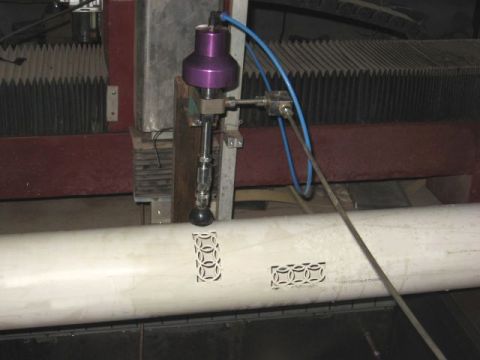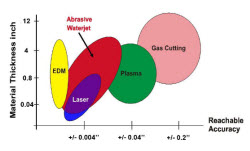The two types of waterjets are the pure waterjet and the abrasive waterjet. Both have unique capabilities proven a benefit to industry.

Pure Waterjet
Pure waterjet is the original water cutting method. The first commercial applications were in the early to mid 1970s, and involved the cutting of corrugated cardboard. The largest uses for pure waterjet cutting are disposable diapers, tissue paper, and automotive interiors. In the cases of tissue paper and disposable diapers the waterjet process creates less moisture on the material than touching or breathing on it. Unplanned down time, common to other cutting processes, cost over $20,000 per hour (US dollar) in some diaper or tissue plants. The waterjet provides the 24 hour per day, 7 day per week, 360 day per year operation required by such applications – maintenance can be scheduled into production.
Pure waterjet attributes:
VERY THIN STREAM (0.004 TO 0.010 INCH IN DIAMETER IS THE COMMON RANGE)
EXTREMELY DETAILED GEOMOETRY
VERY LITLE MATERIAL LOSS DUE TO CUTTING
NON-HEAT CUTTING
CUT VERY THICK
CUT VERY THIN
USUALLY CUTS VERY QUICKLY
ABLE TO CUT SOFT, LIGHT MATERIALS (E.G., FIBERGLASS INSULATION UP TO 24”
THICK)
EXTREMELY LOW CUTTING FORCES
SIMPLE FIXTURING
24 HOUR PER DAY OPERATION
Pure Waterjet Cutting Heads
As you may recall from an earlier section of this document, the basic waterjet process involves water flowing from a pump, through plumbing, and out a cutting head.
In waterjet cutting, the material removal process can be described as a supersonic erosion process. It is not pressure, but stream velocity that tears away microscopic pieces or grains of material. Pressure and velocity are two distinct forms of energy. But how is the pump’s water pressure converted to this other form of energy, water velocity? The answer lies in a tiny jewel. A jewel is affixed to the end of the plumbing tubing. The jewel has a tiny hole in it. The pressurized water passes through this tiny opening changing the pressure to velocity. At approximately
40,000 psi the resulting stream that passes out of the orifice is traveling at Mach 2. And at 60,000 psi the speed is over Mach 3.
********************
Question: How hot is the water in a Mach 3 waterjet stream?
Answer: The water is warmed as it is accelerated to high speed. Frictional forces and other
factors warm the stream as it exits the orifice. In let water temperature provides the starting point.
Water temperature is then raised 2 to 3 degrees for each 1,000 psi. The quick answer is the
Mach 3 jet is approximately 170 to 180 degrees F.
********************
Pure waterjet orifice diameter ranges from 0.004 to 0.010 inch for typical cutting. When waterblasting concrete with a nozzle traversing back and forth on a tractor, a single large orifice of up to 1/10th of an inch is often used.
The three common types of orifice materials (sapphire, ruby, diamond) each have their own unique attributes. Sapphire is the most common orifice material used today. It is a man-made, single crystal jewel. It has a fairly good quality stream, and has a life, with good water quality, of approximately 50 to 100 cutting hours. In abrasive waterjet applications the sapphire’s life is ½ that of pure waterjet applications.
Ruby can also be used in abrasive waterjet applications. The stream characteristics are well suited for abrasivejet, but are not well suited for pure waterjet cutting. The cost is approximately the same as the sapphire.
Diamond has considerably longer run life (800 to 2,000 hours) but is 10 to 20 times more costly.
Diamond is especially useful where 24 hour per day operation is required. Diamonds, unlike the other orifice types, can sometimes be ultrasonically cleaned and reused.

Abrasive Waterjets
The abrasive waterjet differs from the pure waterjet in just a few ways. In pure waterjet, the supersonic stream erodes the material. In the abrasive waterjet, the waterjet stream accelerates abrasive particles and those particles, not the water, erode the material. The abrasive waterjet is hundreds, if not thousands of times more powerful than a pure Waterjet. Both the waterjet and the abrasive waterjet have their place. Where the pure waterjet cuts soft materials, the abrasive waterjet cuts hard materials, such as metals, stone, composites and ceramics. Abrasive waterjets using standard parameters can cut materials with hardness up to and slightly beyond aluminum oxide ceramic (often called Alumina, AD 99.9). In the next section we will explore abrasive waterjet attributes and how the abrasive waterjet cutting head works.
Abrasive Waterjet attributes:
EXTREMELY VERSATILE PROCESS
NO HEAT AFFECTED ZONES
NO MECHANICAL STRESSES
EASY TO PROGRAM
THIN STREAM (0.020TO 0.050 INCH IN DIAMETER)
EXTREMELY DETAILED GEOMETRY
THIN MATERIAL CUTTING
10 INCH THICK CUTTING
STACK CUTTING
LITTLE MATERIAL LOSS DUE TO CUTTING
SIMPLE TO FIXTURE
LOW CUTTING FORCES (UNDER 1 LB. WHILE CUTTING)
ONE JET SETUP FOR NEARLY ALL ABRASIVEJET JOBS
EASILY SWITCHED FROM SINGLE TO MULTI-HEAD USE
QUICKLY SWITCH FROM PURE WATERJET TO ABRASVIE WATERJET
REDUCED SECONDARY OPERATIONS
LITTLE OR NO BURR
Abrasive Waterjet Cutting Heads
Within every abrasive waterjet is a pure waterjet. abrasive is added after the pure Waterjet stream is created. Then the abrasive particles are accelerated, like a bullet in a rifle, down the mixing tube.
The abrasive used in abrasive waterjet cutting is hard sand that is specially screened and sized.
The most common abrasive is garnet. Garnet is hard, tough and inexpensive. Like the pink colored sandpaper found at the hardware store, different mesh sizes are used for different jobs.
120 Mesh – produces smooth surface
80 Mesh – most common, general purpose
50 Mesh – cuts a little faster than 80, with slightly rougher surface.
The mixing tube acts like a rifle barrel to accelerate the abrasive particles. They, like the orifice, come in many different sizes and replacement life. Mixing tubes are approximately 3 inches long,
¼ inch in diameter, and have internal diameters ranging from 0.020 to 0.060 inch, with the most common being 0.040 inch.
Although the abrasive waterjet machine typically is considered simple to operate and ‘bullet proof,’ the mixing tube does require operator attention. A major technological advancement in Waterjet was the invention of truly long-life mixing tubes. Unfortunately, the longer life tubes are far more brittle than their predecessors, tungsten carbide tubes. If the cutting head comes in contact with clamps, weights, or the target material the tube may be broken. Broken tubes cannot be repaired. Today’s most advanced systems incorporate collision detection to spare the mixing tube.
The standoff distance between the mixing tube and the target material is typically 0.010 to 0.150 inch. Larger standoff (greater than 0.080 inch) can cause a frosting to appear atop the cut edge of the part. Many Waterjet systems reduce or eliminate this frosting by cutting under water or using other techniques.
The consumable items in an abrasive Waterjet are the water, abrasive, orifice (usually Ruby) and mixing tube. The abrasive and mixing tube are exclusive to the abrasive waterjet. The other consumables are also found in the pure waterjet.








 Because of the angles that can be cut, part programs may need to have additional cuts to free the part from the sheet. Attempting to slide a complex part at a severe angle from a plate can be difficult without appropriate relief cuts.
Because of the angles that can be cut, part programs may need to have additional cuts to free the part from the sheet. Attempting to slide a complex part at a severe angle from a plate can be difficult without appropriate relief cuts.



